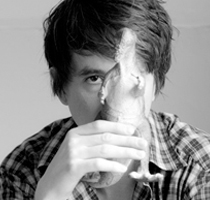The poem “Patternicity†now yields to analysis more easily. “Here’s a face,†it begins, “yours when patterns emerge/ from a snow of machinery.†Note that it’s “aâ€face—any arrangement of features will suffice. The mind seizes upon a pattern to make it recognizable—given a remote similarity, it’s now “yourâ€face, coalescing from a “snow†of inorganic matter. “On your back,†Johnstone continues, “you watch a hawk soar/ across skylights and disappear.†Here we have experience—what looks like a hawk, anyways—streaking across a delimited frame of reference. In a literal description, a skylight; taken more abstractly, our very categories of perception. The hawk enters our field of vision and leaves. We believe—devoutly, superstitiously, passionately—in “careless beauty,†or beauty that takes shape from chaos without intrusive manipulation: “the Virgin Mary†in stained glass, her reflection in the side of a skyscraper. The last image in “Patternicity†is an “axe searching for order in bands/ of pine, the certainty of even land.†An axe is a tool to clear and separate, defining and dividing matter. The axe searches for “order†in the natural environment, the “bands of pine†that perhaps wrinkle and knot into the visage of someone recognizable. Throughout the poem, we push for a sense of the “even land†of rational understanding: an end to a chaotic world that insists on random events.
If Patternicity explores ways in which we make order out of an unpredictable, material universe, it also posits that universe as a place of violence, strife, and suffering. Various kinds of flies hover over these poems, appearing in verse after verse. Whether they’re mayflies, blowflies, drosophilia, calliphoridae, or blackflies, these creatures reinforce a sense of decay and failing flesh. Patternicity is no paean to Nature’s sublimity or aesthetic virtue; rather, it is so full of blood and rot that the collection could have easily been titled The Slaughterhouse Poems (indeed, one longer poem included is called “Abattoir Ghazalsâ€). In “Gravitropism†(the natural process that compels roots to bend toward the earth and stems to bend toward the sky), we “bend against/ the primordial mesh/or ordinary limits,†trapped in “gravity’s cruel grin.†Matter is a “vacant whim,†without tenderness or design. In “Canadian Gothic,†crows merely “endure our stillness,†waiting to “thrust/ their mouths toward our eyes.†In “The Biologist’s Hands,†science and the slaughterhouse are again aligned; here, a “butcher—/ cut[s] animals for taste†instead of knowledge, streamlining a sense of cruelty in both professions. Throughout “Abattoir Ghazals,†the natural environment is personified into oppression and agony—a river is “paralyzed,†a lake “ruined,†a shoreline “wounded;†cold weather “carries illness,†and black oaks “spike†a camp. Such oppressive language recalls Heideggerian forms of environmental dismay; a dam stands over the river, rather than working with it; a forest of oaks becomes a standing reserve, a resource, rather than a part of the poetry of becoming.
Among this material indifference, humans bounce about like pinballs, woefully ignorant and prone to bodily destruction, a “blurr[ing] to violence.†We’re reduced to a “solar system of wounds,†a “fierce jumble of blood and teeth,†while we shake, “tears rivering/ through [our] fingers.†As for knowledge—real understanding of the shapes and patterns that destroy us—we merely know what our failing eyes can tell us. In “The Wash of Flares,†Johnstone’s speaker sums up our struggle: “We are helpless in this country, know/ movement, but not life.†If our predicament is naturally dire (as beings with limited categories), then Johnstone seems to stress our contemporary nadir. A hyper-specialized, post-modern society seems especially removed from a place where natural patternicity makes sense. Technology, philosophy have brought us little: “five hundred years of peace/brought us the cuckoo clock,// desperation oscillating on a pivot.†What can progression provide if “We strike matchsticks until/ we forget how to prepare fire� If I’m allowed to take this line of thinking an inch further and extrapolate from Johnstone’s suggestions, then perhaps he is suggesting that we’re headed toward a dark age of ignorance, “no place to stop/ for the night,/ not anywhere we’ve ever been.†No wonder many of the poems in Patternicity carry an elegiac weight; the poem “Tithonus†seems chiefly poignant if we imagine the eponymous character of Greek myth—forced into immortality but bereft of eternal youth—as a symbol of our culture, aging without renewal in grand, Fisher King or Waste Land-like sterility.
Johnstone is not alone in his efforts to enliven the lyric with the alienating precision of scientific terminology. However, his work with Patternicity should certainly put him at the forefront of such a movement (if it’s really a movement at all). I sense a longing in this collection to bridge the disciplinary gulf between poetry and physiology, a seeking for an intellectual and emotional land-bridge. It will require much patience of its readers, and will certainly skirt the kind of emotional devastation we sometimes come to expect from lyric poetry, but Patternicity’s grim logic and captivating music make life seem all the more diverse, gorgeous, and so very terrible. And that’s what poetry should do: hiding nothing, holding us up to the sky’s empty truth.





No Comments so far ↓
There are no comments yet...Kick things off by filling out the form below.